- Visibility 16 Views
- Downloads 5 Downloads
- DOI 10.18231/j.jco.2023.051
-
CrossMark
- Citation
Invisible Orthodontics: Ceramic appliance vs Lingual appliance -A patient perception survey
Introduction
Orthodontic treatment has evolved significantly in recent years with the introduction of invisible orthodontic appliances, which aim to provide effective teeth alignment while minimizing the impact on patients' daily lives. Two popular options are fixed lingual metal brackets and fixed buccal aesthetic/ceramic brackets.[1], [2], [3] This study aimed to analyse variations in patients' perceptions of oral health, aesthetic acceptance, pain perception, and comfort levels after undergoing orthodontic treatment with these two types of invisible orthodontic appliances.
Materials and Methods
A comparative survey was conducted to assess patient perceptions after the initial levelling and alignment phase of their orthodontic treatment. The survey was created using Google Forms and was distributed to 25 patients who received ceramic (labially treated) brackets and 25 patients who received lingual (lingually treated) brackets. The survey included questions related to comfort level, pain perception, speech impediments, quality of life, aesthetic perception, oral hygiene maintenance, and difficulties with food consumption. Descriptive statistics was obtained from google form. The chi square test was used to investigate significant difference between groups. The whole set of data was entered into MS Excel prior to statistical analysis (P-value 0.05 was regarded as statistically significant). To better understand the statistically significant difference, all findings are presented in tabular and graphical formats.
Results
|
Parameters |
Ceramic Group |
Lingual Group |
||||||
|
|
None |
Mild |
Moderate |
High |
None |
Mild |
Moderate |
High |
|
Comfort level |
8 |
40 |
52 |
16 |
0 |
16 |
68 |
16 |
|
Pain |
4 |
36 |
44 |
14 |
72 |
20 |
4 |
4 |
|
Difficulty in speech |
o |
32 |
52 |
16 |
0 |
12 |
44 |
44 |
|
Aesthetics |
4 |
36 |
44 |
16 |
72 |
20 |
4 |
4 |
|
Food |
4 |
20 |
40 |
36 |
4 |
28 |
52 |
16 |
|
Oral hygiene maintenance |
4 |
24 |
44 |
44 |
4 |
44 |
44 |
8 |
|
Quality of life |
8 |
20 |
60 |
12 |
4 |
24 |
48 |
24 |
Statistical analysis
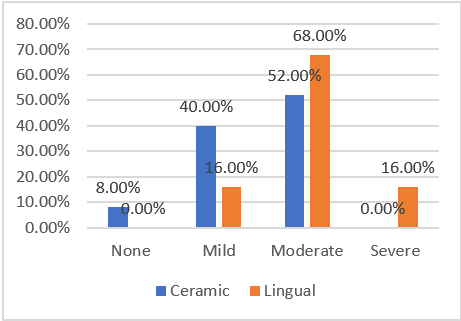
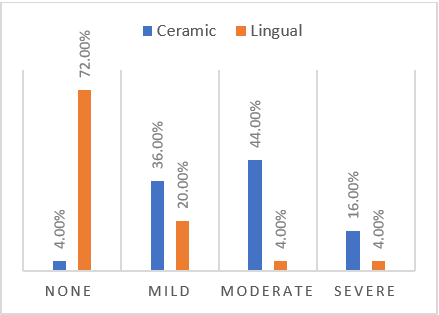
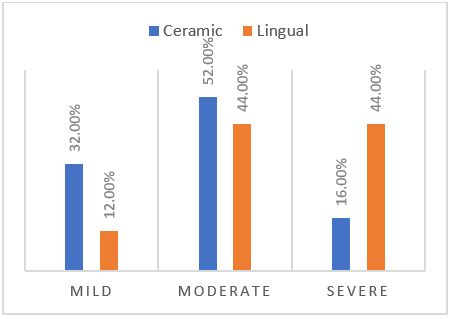
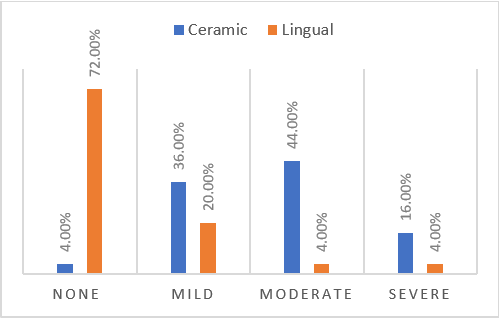
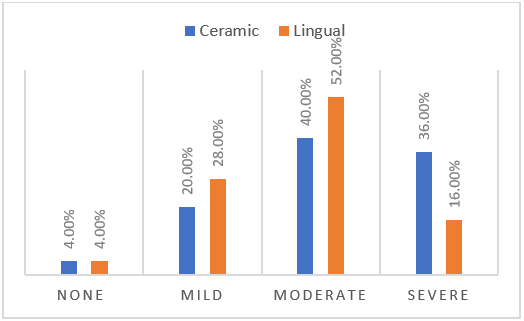
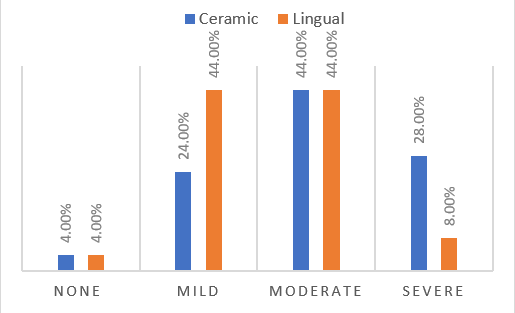
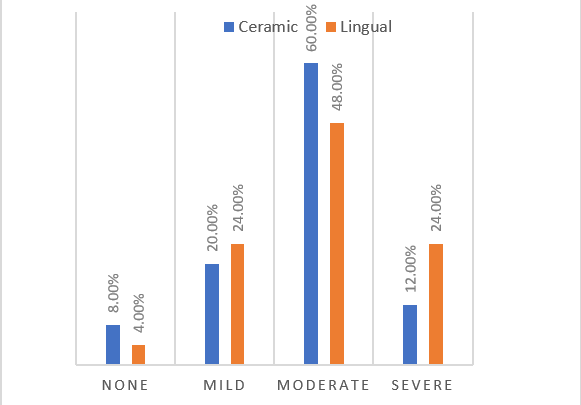
The provided table and graphs presents statistical data on various measured parameters in two groups: the Ceramic Group and the Lingual Group, with percentages across different levels of severity (None, Mild, Moderate, High).
Key Observations
The Lingual Group generally experiences higher levels of pain and difficulty in speech compared to the Ceramic Group.
Discussion
In a comprehensive study comparing the experiences of patients treated with ceramic brackets versus lingual brackets in orthodontic therapy, several key findings emerged7. Notably, patients undergoing treatment with ceramic brackets reported significantly higher levels of comfort and considerably decreased pain perception compared to their counterparts with lingual brackets, as indicated by a p-value of 0.001. This suggests that ceramic brackets may offer a more comfortable and less painful orthodontic experience for patients.
Furthermore, the study revealed that patients with ceramic brackets experienced much less speech impairment and reported a higher quality of life throughout their orthodontic therapy journey. These outcomes underscore the potential advantages of ceramic brackets in terms of speech and overall well-being during treatment.
Aesthetic considerations also played a significant role in the study's findings. Patients with ceramic brackets were found to have considerably higher aesthetic ratings (p=0.001) compared to those with lingual brackets. Notably, a striking 72% of patients with lingual brackets reported no impact on aesthetics, while only 4% of ceramic bracket patients made the same observation. This suggests that ceramic brackets may be a preferred choice for individuals who prioritize the aesthetic aspects of their orthodontic treatment. [4], [5], [6], [7]
However, when it came to oral hygiene maintenance, there was no statistically significant difference between ceramic and lingual brackets (p=0.238), indicating that both types of brackets can be equally manageable in terms of maintaining oral hygiene. [8]
Lastly, in terms of difficulties with food consumption, the study found no significant disparity between patients with ceramic and lingual brackets (p=0.448). This suggests that neither type of bracket significantly impedes a patient's ability to consume food comfortably. [9], [10], [11], [12], [13]
Conclusion
In summary, this study highlights the advantages of ceramic brackets over lingual brackets in terms of comfort, pain perception, speech impediment, quality of life, and aesthetic perception. However, both types of brackets appear to be equally effective in terms of oral hygiene maintenance and food consumption. These findings provide valuable insights for both orthodontic practitioners and patients when considering the choice of bracket type for orthodontic treatment.[14], [15], [16], [17]
Source of Funding
None.
Conflict of Interest
None.
References
- G Robert, S David, B Phiilp. JCO orthodontic practice study. Part 1: trends. J Clin Orthod 2013. [Google Scholar]
- MD Rosvall, HW Fields, J Ziuchkovski, SF Rosenstiel, WM Johnston. Attractiveness, acceptability, and value of orthodontic appliances. Am J Orthod Dentofac Orthop 2009. [Google Scholar]
- K Fujita. New orthodontic treatment with lingual bracket and mushroom arch wire appliance. Am J Orthod 1979. [Google Scholar]
- JPT Higgins, S Green. Cochrane handbook for systematic reviews of interventions version 5.1.0. 2011. [Google Scholar]
- A Liberati, DG Altman, J Tetzlaff, C Gotzsche Mulrow, PC Ioannidis, M Clarke. The PRISMA statement for reporting systematic reviews and meta-analyses of studies that evaluate health care interventions: explanation and elaboration. J Clin Epidemiol 2009. [Google Scholar]
- SN Papageorgiou, L Keilig, I Hasan, C Bourauel. Effect of material variation on the biomechanical behaviour of orthodontic fixed appliances: a finite element analysis. Eur J Orthod 2015. [Google Scholar]
- SN Papageorgiou, E Antonoglou Tsiranidou, J Deschner, A Jager. Choice of effect measure for meta-analyses of dichotomous outcomes influenced the identified heterogeneity and direction of small-study effects. J Clin Epidemiol 2015. [Google Scholar]
- SN Papageorgion. Meta-analysis for orthodontists: Part I How to choose effect measure and statistical model. J Orthod 2014. [Google Scholar]
- H Long, U Pyakurel, L Liao, F Jian, J Xue, N Ye. Comparison of adverse effects between lingual and labial orthodontic treatment. Angle Orthod 2013. [Google Scholar]
- S Geron, N Shpac, S Kandos, M Davidovitch, AD Vardimon. Anchorage loss - a multifactorial response. Angle Orthod 2003. [Google Scholar]
- L Kula Ye, KS Papageorgiou, SN Konstantinidis, K Papadopoulou, C Bourauel. Clinical effects of pre-adjusted edgewise orthodontic brackets: a systematic review and meta-analysis. World J Orthod 2006. [Google Scholar]
- SN Papageorgiou, PK Konstantinidis, A Jager, C Bourauel. A systematic review and meta-analysis of experimental clinical evidence on initial aligning archwires and archwire sequences. Orthod Craniofac Res 2014. [Google Scholar]
- I Mistakidis, H Katib, G Vasilakos, D Kloukos, N Gkantidis. Clinical outcomes of lingual orthodontic treatment: a systematic review. Eur J Orthod 2015. [Google Scholar]
- SN Papageorgiou, GM Xavier, MT Cobourne. Basic study design influences the results of orthodontic clinical investigations. J Clin Epidemiol 2015. [Google Scholar]
- O Guyatt Gh, TP Schunemann, A Knottnerus. GRADE guidelines: a new series of articles in the. J Clin Epidemiol 2011. [Google Scholar]
- L Shamseer, D Clarke M Moher, D Ghersi, A Liberati, M Petticrew, Group. Preferred reporting items for systematic review and meta-analysis protocols (PRISMA-P) 2015: elaboration and explanation. BMJ 2015. [Google Scholar]
- CS Higgins, JP Thompson. A simple method for converting an odds ratio to effect size for use in meta-analysis. Stat Med 2000. [Google Scholar]
